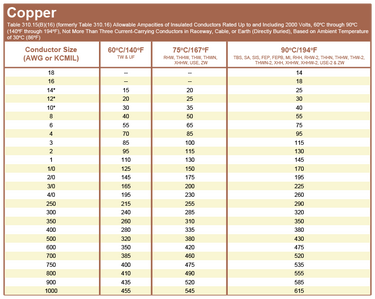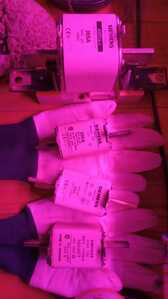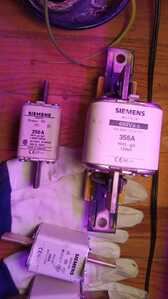PLEASE NOTE: If you had an account with the previous forum, it has been ported to the new Genetry website!
You will need to reset the password to access the new forum. Click Log In → Forgot Password → enter your username or forum email address → click Email Reset Link.
fuse sizing example:
a 90 percent efficient inverter will draw 4000 watts from the battery and only yield 3600 watts of power to the connected appliances....
if I am building a 25.6 volt nominal LifePO4 battery which actually runs closer to 27 volts in the LiFePo4 flat part of the curve...
4000 watts divided by 27 volts = 148.1481 Amps
so if one upsizes the fus by the 1.25 percent factor commonly cited...
then 148.1481 x 1.25 = 185.185 amp fuse for a 4000-watt draw from the battery...
a 185 amp rated wire or larger would also be necessary for the battery to fuse to inverter connection...
so a copper cable of 2/0 size is rated at 145 to 195 amps depending on the insulation rating of the copper cabling.
A 48-volt inverter cable sizing requirement is half the size as it will draw half as many amps at the same power requirements so theoretically at 90 percent efficient inverter at 48 volts will need 2/0 cable up to 8000- watt draw and which produces 7200 watts of power to the appliances connected.... and a similar sized fuse or breaker at the 1.25 upsizing factor of 185 Amps would be the size....
4/0 cable will safely handle more Amps and run cooler for not much more expense than 2/0 copper cabling....(ranging from 195 to 260 ampacities for 4/0 cabling)
again the insulation is a factor in keeping the cabling from overheating and acting like a fuse....
so larger diameter cables will always be safer if you choose the higher quality insulation on larger diameter cables....
I did not calculate these numbers further but 12000 watts would need larger cables and larger fusing to safely operate...
a 12-volt inverter will simply not be able to go to high-watt power draws as the heat will be impossible to control. (fire hazard)
likely why the blind wolf had problems with the 12-volt inverters I suspect....???? and also even with a large battery the inverter at 12 volts will have a limited ability to do large loads....
I suspect the inverters shut down due to excess heat ( at least one hopes they do)
every connection adds more resistance and decreases the efficiency some.... (for you ohm's law experts out there)😎😎
Minus 12 degrees below zero Fahrenheit outside this morning with a wind chill that feels like minus 49 degrees Fahrenheit due to 30 mph winds.... blizzard conditions...🤔🤔
likely why the blind wolf had problems with the 12-volt inverters I suspect....???? and also even with a large battery the inverter at 12 volts will have a limited ability to do large loads...
blind wolf had major problem with his 24vdc GS6000 watts inverter after he blow it up . His BMS is defective . His battery is not the LiFePo4 like yours . He do not have enough battery . He need lots of 4/0 cables so the negative side do not get hot . I think he throw in the towel and gave up . OFF GRID cost a lots of money to make it safe . Battery and cables cost me 3 times what a DIY GS12kw cost . A lot of people gave up DIY off-grid on Youtube and buy ready made inverter and assembled battery like EG4 . Surprise that blind wolf say his Powerjack still works good and run his washer .
yes, the cables and bus bars and fuses and all do add up on the battery side of things.... I am thinking about adding a second set of 4/0 cables on the 15k inverter,,,, I bought some 4/0 for 4 buck a foot and already have the crimper and lugs to add more cable...
a proper DC-rated disconnect is still an expensive item to invest in....
never see much about good DC-rated disconnects >>>>
I thought blind wolf had a 12-volt inverter,,,
but 24 volts would be slightly better,,, if they can ever get it to function...
not sure about his battery type, but the BMS is always a possible malfunction concern...
make shaving a redundant shutdown safety a must....
but perhaps it was a charging issue of the battery not charging to the required voltage to function correctly with the inverter...thanks for the reply
the newer all-in-one communicate with each other but still have all kinds of bugs and things to work out as they are not yet to a standardized plug-and-play type device...
NH fuse:
NH type fuse are also known as knife blade fuse and also known as DIN NH blade fuse
It seems that the class t and some other types of fuses are not approved in the ABYC (boating standards for the insurance industry as they have reports of exploding)
as one deep dives into the fusing and breaker and disconnects in the dc world there are tons of jargon to interpret
the BMS has the fastest components to fail so the fuse may not protect the BMS ((so it is possible the BMS will actually be the sacrificial lamb))
according to more knowledgeable electrical-type folks than me...
I am not an electrical engineer or an electrician .....
but I do try to learn from those with more actual data to show....
not chinesium data either....
lots of sellers of garbage out there on the internet...
I prefer the engineer do the research!!! not some chinesium selling copycat....
I am presently compiling information for the fusing and whatnot for the new 8x8 64-cell ESS using the 280Ah version 3 cells (64 of them) for a 57344Wh battery at 25.6 nominal volts....
essentially a bigger gas tank if you will...
3.2volts x 280Ah x 64 cells = 57,344 Wh
the large ESS battery will normally run closer to 27 volts in the flat part of it discharge curve....
it would be helpful if editing was allowed for longer but a new post will be used ... I just ran across >>>>after doing a lot of typing the editing said it was timed out so why would the edit button function if it was not going to allow the edit to be saved and posted....
that is a really dumb part of this edit button making it unusable or at best undependable...
perhaps the software engineers could make the software more user friendly in the future....
diy solar allows editing on their forum as do other forums
especially helpful for the hunt and peck typists....!!!!! who find multiple mistakes after posting
NH fuse:
unfortunately, the 3200-watt HF inverter is not fused at this moment but still kicking...
LiFePo4 typically run at 3.45 volts per cell or 27.6 volts for an 8S build...
3200 watt divided by 27 volts should have an approximate 148 amp fuse after adding in the 1.25 upsizing factor so a 150 amp fuse would be good and the cable size should also be a minimum of 150 amp capable or large cable for a safer installation.... is how I figure it!!!
I will not max out the 3200-watt inverter at any time that is just not in the plan at all.... it should run comfortably at 75 percent of 3200 watts continuously so 2400 watts is sufficient...load... it is a 120-volt inverter and runs spot on (CNSWIPOWER 3200-watt HF 24-volt inverter)
The other factor I am seeing is some inverters work better when matched correctly to the battery...
If the battery is too small and the voltage sags too much then the loads suffer....
so larger size inverter cables with less resistance will help prevent low voltage issues (assuming the battery is of adequate size), and the inverter running at closer to 120 volts makes a big difference also...
It is still too darn cold outside but the sun is shining at 10 degrees below zero Fahrenheit and less wind out today I think they report the wind at 18mph and the wind chill is a balmy negative 33 degrees below zero Fahrenheit today January 14th, 2024..🤔🤔.
solar PV panels are melting off the ice today...😎
the small loss of the NH-type fuse is tiny compared to the LF inverter's inefficiencies...
The CNSWIPOWER 3200-watt HF 24-volt inverter has a 9-watt idle draw so that is good for running the lights and leaving on or off with minimal draw from the LiFePo4 batteries... it has been running continuously for about the last 2- 3 months...
I think one needs to account for the various losses to make their systems more efficient....🤔
If the battery is too small and the voltage sags too much then the loads suffer.. so larger size inverter cables with less resistance will help prevent low voltage issues (assuming the battery is of adequate size), and the inverter running at closer to 120 volts makes a big difference also.
Voltage sags too much will damage the microwave oven and refrigerater and freezer and overheat the motor . AC motor will run slow and the DC cable will be hot .
@dickson Luckily i have not had the problem with damage to any expensive appliances or the voltage sag issue;;;;
but I did make a kill-a-watt meter stop functioning.... suspect is was a surge or something,,,, but do not know,,,, possibly too many watts at one time running through it killed it off... think I read someplace they were not good for over 1800 watts but not sure...
the kill-a-watt LCD screen is dead,>>> so to the dunnage pile it goes....
Battery DC voltage sag will damage equipment . I have EMP surge protection now . Loose battery connections and not enough 4/0 cables will cause DC volage sag . The inverter AC output drop from 120vac to 98vac and the microwave oven and refrigerator and freezer make a loud vibration and humming noise . My washer motor just hum and then stop . No damage since I was home and shut off the Powerjack . Brown out by the utility overheat and destroy my swamp cooler motor 10 years ago .
have not gone down the EMP surge protection equipment route sufficiently yet..... but have been thinking about that also.
wonder if the blind wolf ever looked at the voltage sag issue,,,
but his old Powerjack inverter ran his washer (interesting) so must of been some other problem with the 2 GS-6 inverters,,,, I know he was still waiting for them(SID Y SEAN) to have time to fix them for him last I read but do not follow all the threads
I would be disappointed if the 6k inverter would not run a washing machine
🤔
an electrician from Germany told me i needed to use a 250 amp NH fuse and two 4/0 copper cables to positive and 2 4/0 to negative on the 6000-watt 24-volt inverter.
hmmm hmmm >>>> that is a lot more copper cable than I have been using but it does explain the double positive and double negative connections on the back end of the 6000-watt and 15000-watt 24-volt inverters better...
I had only used a single 4/0 copper inverter to connect to the inverter from the lifepo4 battery before.
I think I will add more cables for better transfer of power to the heavy loads.... sounds like a good upgrade plan to me...
the 250 Amp Siemens NH fuse is the same size fuse holder as the 355 Amp Siemens NH fuse....
I only have two of the larger fuse holders at this moment.
The German electrician said I could parallel 3 of the Siemens 160 Amp NH fuses but would need cable to support 480 Amps then...
two 160's in parallel would be 320 Amps ,,,, as I have some triple fuse holders for the small size Siemens NH fuse also...
still trying to gain a few more fuse holders of the larger size....
I have 3 of the 80 Amp Siemens NH fuses that I could put in parallel to get 240 Amp also.... in the smaller size fuse holder....
the small-size NH fuse holder is relatively easy to obtain.... the large-size NH fuse holder is quite expensive to obtain for the NH style fuses and a bit difficult to make sure you are purchasing the right size also.... at least thai is what I have encountered so far....
23 degrees Fahrenheit outside early this morning January 22nd, 2024 🤔🤔
... hope the wind quits blowing as the drifting snow is making it impossible to get to the main road.....😎
my 5000-watt inverter will have 2 4/0 cables one to each terminal >>>> 2 negatives and two positive 4/0 cables, ((two positives 4/0 cables, two negative 4/0 cables)) and a 250 amp Siemens NH fuse...
5000 divided by 25.6 = 195 amps approximately so if I use the 1.25 rule of thumb to upsize the fuse
195 x 1.25 = 244 Amp fuse, so a 250 Amp fuse should be about right...


